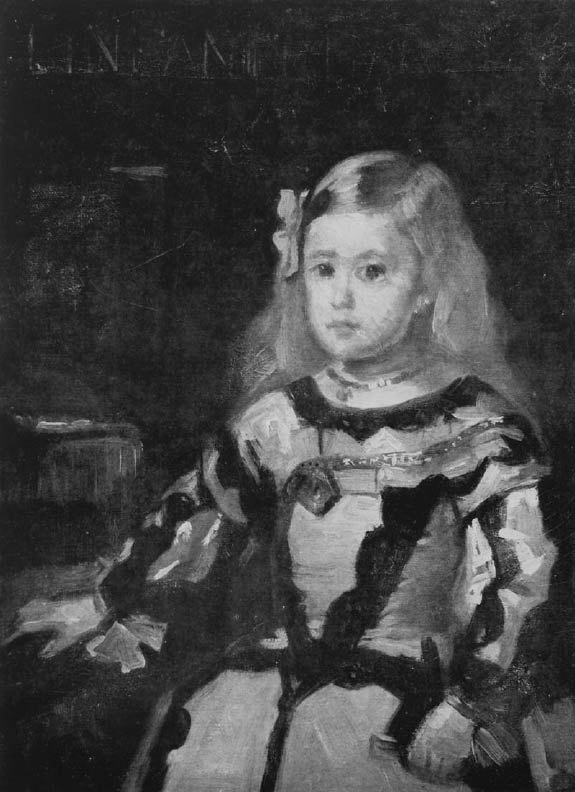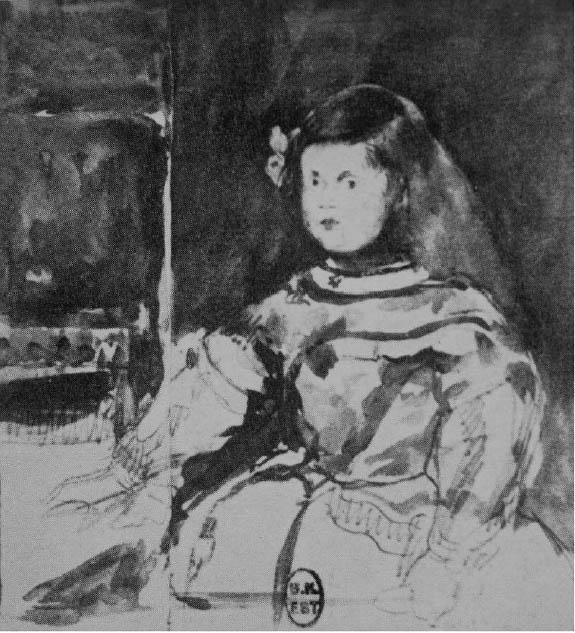MANET'S LOST INFANTAALBERT BOIME, & ALEXANDER KOSSOLAPOV
2 ART HISTORICAL VIEWPerhaps no other modern French painter has been submitted to as much intensive scrutiny as �douard Manet. Every conceivable aspect of his life and work seems to have been exhaustively explored, leaving little fresh ground for either the aspiring scholar or seasoned veteran to cultivate. Yet despite the ardent devotion of scholar and critic to Manet and his work as a pathway to modernity, there remain conspicuous gaps in the record, especially concerning his early efforts to modernize canonical models. It is incontestable that Manet deliberately set out to challenge
Perhaps one of the most vexing lacunae in Manet's oeuvre has been the presumed physical absence of the copy that we know he made of Vel�zquez's notorious Infanta Maria Margarita and for which he registered in the Louvre to copy in the period 1859–1860. (We may immediately dismiss the spurious claim of the notorious forger, Eric Hebborn, that his teacher, W.A. Cuthbertson, painted this copy from Las Meninas in the Prado; in Las Meninas the Infanta faces in the opposite direction and wears a different costume! [Hebborn 1991, 45–47]). Although the painting under discussion was an excellent contender for the missing picture and had been proposed by Andrew Brainerd for several years, its lack of provenance and signature had cast a dubious pall over its origins. The oil study set forward by Brainerd as the lost Manet was first published by Anne Coffin Hanson in 1977 in her pathbreaking Manet and the Modern Tradition, where the copy was considered a likely “contestant” for work long known to have existed but never located and presumed lost or destroyed (Hanson 1977). Although she added that it was impossible in the present state of knowledge to firmly identify the picture and so consigned it to unknown authorship, she argued that of all the copies after the popular image that had surfaced over the years, this was the one example that came closest to approximating the methods and colors as well as the freshness and vivacity of Manet's technique and style. The hesitation of Hanson and others to assign an unequivocal attribution was understandable, given the absence of provenance and signature, two existential conditions the want of which naturally render any work problematic. Since Hanson published the painting, however, the work has been rigorously submitted to state-of-the-art scientific analysis. The results of this scrupulous examination ratify what the heart has known all along, and at long last we can state with a comfortable degree of certainty that the outcome of the application of the latest scientific methods to this picture has eradicated whatever reservations specialists may have felt over the years absent the two conditions noted above. Although art historians and art experts seem to be nervous about relying too heavily on the application of conservation science for authentication, in a case of this sort conservation science should be seen as the inevitable and necessary adjunct to sound connoisseurship. Regrettably, many art experts still mistrust the methods of the scientist, but it is our firm belief that not only is this gulf not unbridgeable, in future this collaboration will be the norm. It has always been a Previously, a number of Manet specialists entertained the possibility of this sketch/copy's being a Manet simply on the basis of surface appearances and the historical record. Indeed, on the basis of internal evidence—style, paint layer, and physical structure— there has never been any solid argument mustered by the critics and historians against a Manet identification in the case of the Infanta, and now that all the scientific data have been assembled and analyzed, the attribution seems to us indisputable. There is no need to rehash the abundant historical data of Manet's profound debt to the Spanish master so amply documented in all the monographs. During his trip to Spain in September 1865, he wrote of his admiration for Vel�zquez in rapturous terms, the mere sight of whose work seemed a fulfillment of his most cherished ideals of painting. We know that he registered to copy at the Louvre on July 1, 1859, and two copies after paintings attributed to Vel�zquez belong to that period: Reunion of the Thirteen Cavaliers, usually dated 1859–1860, and the Infanta Maria Margarita, reportedly executed concurrently with Edgar Degas's (1834–1917) reproduction of the same work in 1859 (Reff 1964; Boggs 1958). Vel�zquez's portrait of the Infanta Maria Margarita has been located in the Salon Carr� of the Louvre Museum in Paris since 1816, and it became an object of great interest during the Second Empire at the height of the Spanish Revival. Manet did not fail to acknowledge this connection with Vel�zquez's portrait in his most provocative Salon display of the period, the Olympia of 1863; he slyly transferred the pink flower from the head of the innocent Infanta to the head of his brazen courtesan to complicate his visual associations with the past and parodic challenge to tradition. Manet's emulation of Vel�zquez has recently been made the centerpiece of a major exhibition, Manet/Vel�zquez: The French Taste for Spanish Painting, organized in 2002 at the Mus�e d'Orsay in Paris and shown at the Metropolitan Museum of Art, March through June 2003. The show featured Vel�zquez and Manet side by side, demonstrating the full measure of the impact of the Spanish master on Manet's developing sensibility. Here the viewer had the opportunity to witness directly that Manet's taste for quizzical visual surprise fully exploited Vel�zquez's paradoxical imagery (Schjeldahl 2002). Manet's paraphrase of the Infanta uses a smaller portion of the actual work in the Louvre, turning what is essentially a three-quarters length of the figure into a portrait bust that iconically centers the object. What is remarkable in both the drawn and painted copies of his early phase is his tendency to reduce the actual torsos of the originals to primarily head and shoulders—typical of his master Thomas Couture's drawing style—and to centralize them (Meller 2002). Manet's Portrait of Roudier (Cabinet des dessins, Mus�e du Louvre, Paris) of 1860, for example, showing head and shoulders only of the sitter, could easily pass for the master's work (Boime 1980). The residual influence of Couture on his disciple is perfectly understandable given Manet's relatively recent departure from the studio where he spent almost six years (1850–56). Couture's recipes, however, left an indelible impression on Manet, who continued this practice throughout most of his career, as seen in a series of quick studies of females in the early 1880s (Rouart and Wildenstein 1975). Some of the most startling examples of this approach are the drawn portraits of Gustave Courbet, Claude Monet, and Edgar Allan Poe, and the etched portrait in profile of Charles Baudelaire (ca. 1862–65), all of which dramatically attest to this tendency (Rouart and Wildenstein 1975, vol. 1, nos. 20, 55). In the case of the Infanta, Manet's skillful cropping adapted an off-center figure to his favorite centering mode. Andrew Brainerd has analyzed this tendency to compositional centrality and symmetry in Manet's early portraiture and copying practice in what he describes as the “Manet Matrix” (Brainerd 1988, 41). Although in both his watercolor (fig. 4) Michael Wilson first called attention to the singular process of scraping in Manet's methods, and since the publication of his study, other scholars have noted this propensity of the artist for scraping and rescraping down to the ground (Wilson 1983; Bareau 1986). The oil copy of the Infanta is no exception, and transmitted light photography reveals this salient characteristic of Manet's method in several places. These material traits substantiate the chemical evidence as analyzed by McCrone (Brainerd 1988), whose findings on the pigments in two established early Manet paintings—The Spanish Ballet of 1862 (Phillips Collection, Washington, D.C.) and Woman Pouring Water (Ordrupgaard Collection, Copenhagen) of ca. 1858–60—demonstrated unique optical and chemical properties common to all three and verified that the lead white of the two control samples and that of the Infanta probably originated from the same production lot. This finding means that Manet and the painter of the Infanta used the same pigments from the same supplier or suppliers in approximately the same time period. McCrone estimated the probability of coincidence in trace element concentration at one chance per billion. According to McCrone, the lead white in the The Spanish Ballet and the Infanta could not “be more similar if they had been squeezed from the same tube of paint” (Brainerd 1988, 174). McCrone further found that the agreement of pigment composition in all three examples provides strong support in favor of dating the Infanta near the middle of the 19th century. Finally, the scrupulous x-ray radiography and special photographic analysis, detailed below, further confirm the validity of McCrone's findings (Brainerd 1988) in revealing aspects of methods—preparatory painted contours,
|


